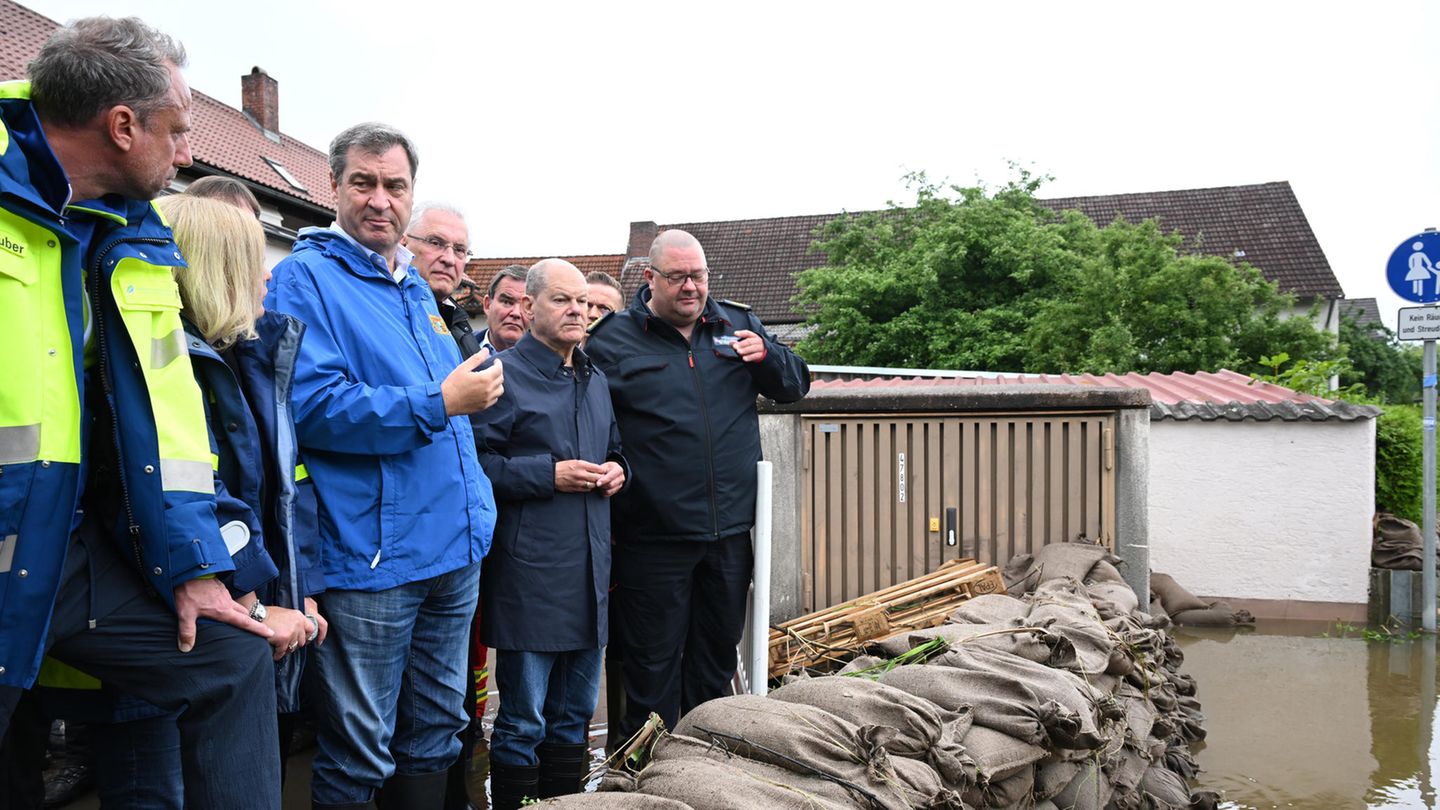Should property owners be forced to take out natural hazard insurance against flood damage? This has been discussed for a long time, but so far the taxpayer has regularly paid for uninsured damage. What are the pros and cons of compulsory insurance?
This is original content from the Capital brand. This article will be available for ten days on stern.de. After that, you will find it exclusively on capital.de. Capital, like the star to RTL Germany.
After the catastrophic floods in 2002, it was already discussed once before: compulsory insurance against natural damage such as heavy rain, landslides and storm surges. At that time, there was a working group of the federal and state governments, which was then discontinued two years later without any results. After the heavy rain floods that poured into the Ahr Valley in July 2021, the debate came up again. And in the summer, there could now be compulsory insurance if the federal government gives in.
The federal states are putting pressure on the government to “push forward the goal of compulsory natural hazard insurance” in March 2023. The federal government should quickly propose a nationwide solution.
All difficult things come in threes
This is the second attempt after the Ahr Valley flood. The federal government had put a stop to the first attempt with concerns that the costs for those insured might be too high. That was in 2022, after Russia had invaded Ukraine and energy prices had fueled inflation. During this phase, the traffic light coalition did not want to create “further hardship that would be difficult to overcome”.
Now the third attempt: A federal-state working group has been meeting again since December – and on June 20, its results will be negotiated between Chancellor Olaf Scholz (SPD) and the state leaders, according to the plan.
Only every second house has natural hazard insurance
You insure your household contents with home contents insurance and your house with building insurance. Both can be taken out with or without protection against natural hazards.
The current debate is about insuring houses. Of the 8.5 million building insurance policies, only half include flood protection. These do not necessarily include houses in particularly vulnerable locations, because the higher the risk, the more expensive the insurance. And the price puts many owners off.
Why so few are insured
Severe flooding does not occur very often, and those affected underestimate such risks. There are psychological reasons for this: the risk seems vague and distant – and therefore not urgent.
Added to this is the so-called Samaritan dilemma: if a flood disaster occurs, politicians cannot stand on the sidelines and watch. Especially not – as is the case now – before elections. So “unbureaucratic help” is promised – regardless of whether a building was insured. Many private individuals also help with donations.
This often gives homeowners the impression that insurance is not necessary. But if few people take out insurance, the insurance tends to become more expensive. This in turn discourages people from taking out insurance at all.
So what should we do? There are two camps in the debate: some want compulsory insurance, while others just want to create incentives for it.
What speaks for compulsory insurance
- If it were mandatory, (almost) all homeowners would be insured. The state would not have to help out, and no one would lose their livelihood.
- There would be no problems in determining who would be responsible for which damages. In the Ahr Valley, these have in some cases significantly delayed payments.
- It would remedy the injustice that your taxes are now being used to pay for many damages even by those who do not even own their own home.
- As the debate is currently going, compulsory insurance would likely provide for different risk classes, similar to car insurance. If the house is in a vulnerable location, the policy would be correspondingly more expensive – depending on the location and the security measures in place at the house. This would create an incentive to protect the house better in order to then have to pay lower premiums.
- Or not to build at all: Every year more than 1,000 new buildings are built in “highly vulnerable flood areas,” warns the . In total, there are over 270,000.
What speaks against compulsory insurance
- An important principle is personal freedom, and this of course includes freedom of contract: everyone has the right to freely enter into contracts – or not. There are already compulsory insurances, but they either serve to protect life and limb (health insurance) or to protect third parties from damage (car liability insurance). Insurance against damage caused by one’s own actions is not so common.
- It is unclear whether and how an obligation can be enforced.
- Since insurance is compulsory, some homeowners may be overwhelmed by the costs. In the particularly at-risk zones, in hazard class 4, flooding occurs statistically once every ten years. According to the working group of the Justice Ministers’ Conference, the insurance there (with a small deductible) could cost a high three-digit to four-digit annual premium for a typical single-family home.
- Conversely, an obligation would also apply. The problem: For small insurance companies and especially for pure online providers, this could mean a loss-making business. If a company has only a few insured people, it is difficult to calculate a rare and expensive risk. In addition, in many (more at-risk) cases, a home visit would probably also be necessary – difficult for small online insurers.
- Even owners with a very low risk would have to pay for insurance that they would probably never need. Estimates range from 50 to 100 euros per year. Conversely, these customers are particularly important in keeping the insurance affordable overall.
Compulsory insurance: The legal situation
The court also considers it fundamentally possible to introduce compulsory insurance if the insured are classified according to their personal risk and the costs remain reasonable. In its decision on the introduction of nursing care insurance, the Federal Constitutional Court expressly stated that the legislature has leeway when it comes to providing basic services. The ruling could therefore also be applied to natural hazard insurance.
However, the level of costs could still be an issue. The insurance association GDV estimates that, in view of climate change, insurance costs could double in just ten years. There are also voices, for example among consumer associations, who fear that insurance will be passed on to rent – and call for social cushioning of insurance premiums.
Reinsurance against natural hazards
Insurance companies also take out insurance: In the event of particularly large-scale damage, there are so-called reinsurers who protect normal insurers from being unable to meet their obligations.
This was one of the sticking points at the first attempt in 2003: Is the state prepared to assume part of the risk with an insurance guarantee? At the time, a 22 billion euro guarantee was being discussed, which put many politicians off. In view of the recent flood damage, however, this sum may no longer be as daunting: the federal government has made 15 billion euros available for the Ahr Valley alone.
The political camps
The states are now putting pressure on the situation: in recent days, the heads of government Malu Dreyer (SPD, Rhineland-Palatinate), Markus Söder (CSU, Bavaria) and Hendrik Wüst (CDU, NRW) have once again stressed that compulsory insurance is necessary. Saarland’s Prime Minister Anke Rehlinger (SPD) was particularly clear: “I have absolutely no understanding of why we have the same conclusion every time from flood to flood and the Federal Minister of Justice is simply sitting it out,” she told the Funke media group. “To the detriment of tens of thousands of people and taxpayers who are now once again compensating for damage in Saarland.”
The Federal Ministry of Justice is actually one of the main opponents of compulsory insurance – and cites this as the main reason. The property owners’ association Haus & Grund is also against a requirement, saying it would “not prevent a single case of damage,” says association president Kai Warnecke.
The CDU/CSU parliamentary group in the Bundestag is somewhat in between: unlike the CDU state premiers, it is not one of the supporters of a requirement. At the same time, however, it wants to make a new attempt to significantly increase the number of insured people. There is currently one member of the parliamentary group in the Bundestag who wants to have natural hazard insurance added to the normal building insurance for all insured people from a certain date. Owners who absolutely do not want this could then vote it out “within a certain period of time after being informed of the consequences”.
Chancellor Scholz also has his rubber boots on
It is not unlikely that compulsory insurance would be introduced in a similar way. It is difficult to force homeowners to take out insurance. A car will be immobilized if it does not have liability insurance. A house cannot be immobilized. One idea is to raise property taxes as a punishment. The real punishment, however, would be that once compulsory insurance is introduced, people will no longer rush to those who refuse to take out insurance as Samaritans.
Chancellor Olaf Scholz has not yet commented on the obligation to take out insurance, but on Monday he took a look at the flood situation in Bavaria himself – together with other politicians in rubber boots like Markus Söder. And he made the classic Samaritan promise of politics: Solidarity is “what we as people need most,” he said in Reichertshofen. “We will do everything we can, including using the federal government’s resources, to ensure that help can be provided more quickly.”
Source: Stern




